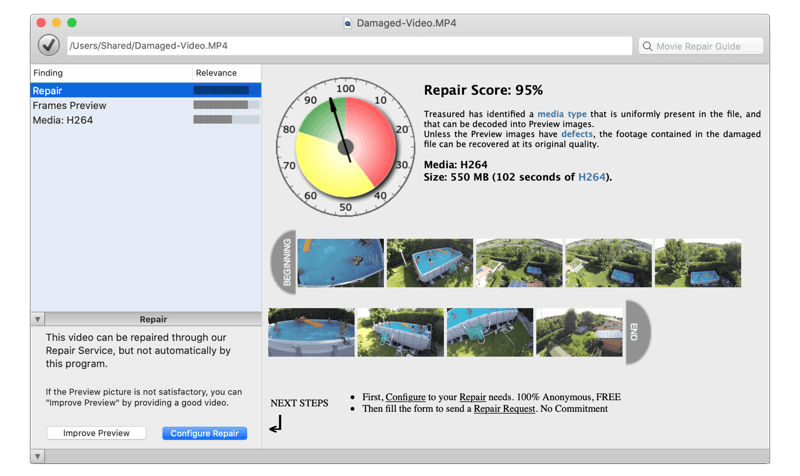Unsupported Browser
This page probably won't work great in Internet Explorer. We generally only support the recent versions of major browsers like Chrome, Firefox, Safari and Edge.
Not just a missing header!
A common misconception regarding corrupted video repair is that the problem can be solved by adding to the damaged files a small piece of data called a “header” — if inserted at the beginning — or a “footer”, if added at the end.
“Headers” and “Footers” only work in trivial cases
Headers and footer are simple data structures that tell the computer what the file contains, in broad terms.
For example, you can wrap a file containing Linear PCM audio with either a WAV or a AIFF header.
For those audio containers, a header is enough, because PCM audio can be described by just a few parameters, like sampling frequency, bit depth and “endianness”.
But if the file content is complex to describe, with multiple tracks (audio and video), and variable attributes for each frame — size, duration, role — the video file will need multiple indexes to operate.
Serious video formats have indexes!
Imagine that you start watching a video, get bored, and jump to the middle to see what happens next.
The computer needs to figure out immediately which images should be displayed.
Where can those images be found inside the file?
The video container and its indexes make this possible.
Indexes work like the table of contents of a book, which lets the reader find the page he wants to read.
Inside a video file, media data — encoded images and sound — occupies most of the space.
It is “wrapped” by the container object, that gives coherence to the whole:
Why is reindexing needed at all?
Unfortunately the container object, which gives the coherence to the video file, is also the most fragile part of it.
It can be missing, or have lost its tight coupling with the encoded media it references to.
- In failed recordings, indexes are missing (because indexes are written after recording ends)
- In recovered files, indexes are missing or useless (because referencing to wrong positions inside the file)
Therefore, a corrupted video files looks like a blob of encoded images and sounds, with no structure to make sense of it.
Reindexing consists in analyzing the raw data, in making sense of it.
We fix the video by re-creating a valid container to wrap the encoded media found inside the damaged file.
We re-build the corresponding indexes, metadata and descriptors.
How reindexing Works
Pattern matching, parsing, indexing
Re-indexing is done through a specific software tool, that performs the following operations:
- Read the source file, looking for specific patterns that can indicate the boundary of frames
- Parse the frames, to verify that we have a well-formed image or sound, not a false positive or garbled media
- Copy the verified frames to a new file (that will become the repaired video in last step)
- Register the frames in corresponding indexes
- Wrap the repaired video with header, indexes, descriptors, metadata and footer
Only when false positives are removed does the layout emerge.
The two most common containers that we repair, MP4 and MXF, are very different formats.
But the essence of re-indexing is the same: pattern matching, parsing, verification, registering, wrapping.
Zero tolerance
Audio-visual formats have been designed to keep file size as low as possible, at the expense of resilience.
Any error, even a single bit flipped in the bitstream, can cause audio and video to be glitched for several seconds.
Those strict requirements also apply to re-indexing:
Any error, even a single missed frame or a false positive, will cause the repaired video to have visible glitches.
The staggering number of codecs, cameras, and recording settings, makes a universal re-indexing algorithm impossible to design:
Patterns found inside a corrupted file can be interpreted in many different ways.
Repaired video will be bad.
Therefore, only a specific tool, designed to repair one type of video and only one, will have a chance to make no mistake and connect all the dots correctly.
Try Treasured to reindex your damaged files!
Our service offers:
- FREE diagnostics and preview with Treasured
- FREE sample of repaired video
- Try before you buy with a FREE trial of your Repair Kit
- Enjoy FREE customer support by speaking directly with our trained experts
- Invaluable expertise, dedication and second to none customer service

Treasured
Video Repair — online
Mac, Windows, Linux
Why a specific tool is required
Generic tools will invariably generate low-quality videos, with too many glitches to achieve broadcast quality.
Even reasonably specialized tools will make a mistake from time to time.
This is why our service develops a specific Repair Kit for your damaged files.
Which of those Repair Kits will repair a corrupted Lumix S1H clip?
Click on a Repair Kit below to see how differently each one performs on the same bad file.
codec H.265 UHD

codec H.264 UHD
codec H.264 UHD
allegedly repairs anything
Solution: Your Repair Kit, developed by our technicians
Our team of technicians will prepare the specific Repair Kit that can fix your files and guarantee a perfect result.
To get started, try Treasured on your files, or click on Live Assistance to chat with the team.

